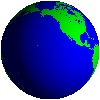










Leachate and Leachate Testing
The main sources of land pollution are municipal
waste disposal, illegal hazardous waste disposal, abandoned hazardous waste
sites, and underground tanks. Contamination of land from wastes dumped
on them threatens not only future uses of the land itself, but also the
quality of the surrounding air, surface, and groundwater. Pollutants
on the surface of the land or in the soil frequently move to surrounding
air and water, particularly groundwater. Even at properly run disposal
sites, land contamination can contribute to air and water pollution because
small quantities of toxic substances may be dumped with other household
wastes. Rain water seeping through these buried wastes may form leachate.
Leachate is the liquid that results when water moves through any non-water
media and collects contaminants. For example, water, as it trickles
through either wastes or soils where agricultural pesticides or fertilizers
have been applied, forms leachate which can percolate down through the
soil and may result in contamination of groundwater.
Source: Ann Boyce, Introduction
to Environmental Technology, Van Nostrand Reinhold, 1997.




